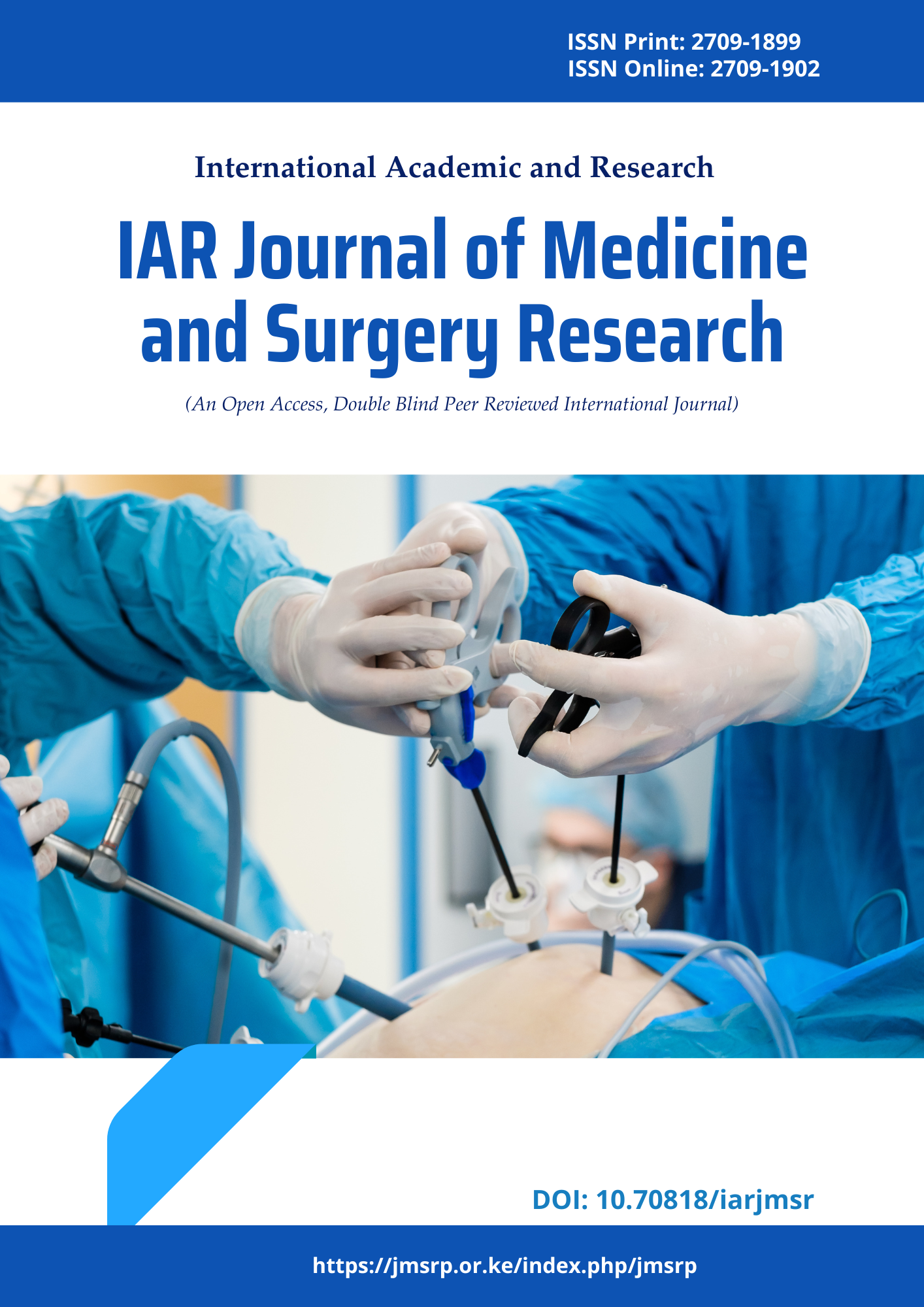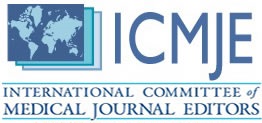Prediction of Non Invasive Ventilation Failure in Critically Ill COVID 19 Patients
DOI:
https://doi.org/10.70818/iarjmsr.2025.v06i01.0154Keywords:
HACOR score, NIV, COVID-19Abstract
Background: Non-invasive ventilation (NIV) is recognized as a practical and effective method for assisting selected patients with respiratory issues. The HACOR scoring system evaluates heart rate, acidosis, consciousness, oxygenation, and respiratory rate and has proven to be predictive of NIV failure in critically ill patients like COVID-19 patinets. Aim: To determine the predictibility of HACOR score to identify NIV failure early in patients with respiratory failure linked to COVID-19. Methods: This cross-sectional study was carried out at the ICU of Bangabandhu Sheikh Mujib Medical University (BSMMU) and Dhaka Medical College Hospital over a one-year period. It involved 40 patients who were administered NIV via a conventional ventilator in spontaneous mode and selected based on specific inclusion and exclusion criteria. Informed written consent was obtained from each patient’s guardians. Upon admission to the ICU, the HACOR score of each patient was measured after one hour of NIV treatment, assessing factors such as heart rate, pH levels for acidosis, and oxygenation through the PaO2/FiO2 ratio, along with respiratory rate. Analysis was performed with both manual methods and software SPSS version 24. Results: NIV failure occurred in 33 (82.5%) patients with only 7 (17.5%) achieving psuccessful NIV. Older patients experienced NIV failure significanly higher compared to those with successful outcomes (average ages 61.79±17.28 vs. 47.57±11.92 years, p=0.045), and male patients were predominant (66.66%). The predominating comorbidities were diabetes mellitus (57.5%). The HACOR scores were significantly higher in patients who failed NIV compared to those who succeeded (8.18±2.18 vs. 4.71±1.5, p=0.002). Receiver operating characteristic (ROC) curve analysis established a HACOR score cutoff value of 5 after one hour of NIV treatment for predicting NIV failure in the study population, demonstrating a sensitivity of 93.9% and a specificity of 57.1% (AUC: 0.905). Conclusion: Despite the study's limited sample size, findings suggest that the HACOR score may serve as an early indicator of NIV failure in critically ill patients with COVID-19-related respiratory failure. Future research on a larger scale is anticipated to validate and expand upon these important insights.
References
Guia, M. F., Boléo-Tomé, J. P., Imitazione, P., Polistina, G. E., Alves, C., Ishikawa, O., Ballenberger, M., Mina, B., Fiorentino, G., Esquinas, A., & Scala, R. (2021). Usefulness of the HACOR score in predicting success of CPAP in COVID-19-related hypoxemia. Respiratory Medicine, 187(1), 1–10.
Duan, J., Wang, S., Liu, P., Han, X., Tian, Y., Gao, F., Zhou, J., Mou, J., Qin, Q., Yu, J., Bai, L., Zhou, L., & Zhang, R. (2019). Early prediction of noninvasive ventilation failure in COPD patients: Derivation, internal validation, and external validation of a simple risk score. Annals of Intensive Care, 9(108), 1–10.
Innocenti, F., Giordano, L., Gualtieri, S., Gandini, A., Taurino, L., Nesa, M., Gigli, C., Becucci, A., Coppa, A., Tassinari, I., Zanobetti, M., Caldi, F., & Pini, R. (2020). Prediction of mortality with the use of noninvasive ventilation for acute respiratory failure. Respiratory Care, 65(12), 1847–1856.
Bhatraju, P. K., Ghassemieh, B. J., Nichols, M., Kim, R., Jerome, K. R., Nalla, A. K., Greninger, A. L., Pipavath, S., Wurfel, M. M., Evans, L., Kritek, P. A., West, T. E., Luks, A., Gerbino, A., Dale, C. R., Goldman, J. D., O’Mahony, S., & Mikacenic, C. (2020). Covid-19 in critically ill patients in the Seattle region—Case series. New England Journal of Medicine, 382(21), 2012–2022.
Carrillo, A., Lopez, A., Carrillo, L., Caldeira, V., Guia, M., Alonso, N., Renedo, A., Quintana, M. E., Sanchez, J. M., & Esquinas, A. (2020). Validity of a clinical scale in predicting the failure of non-invasive ventilation in hypoxemic patients. Journal of Critical Care, 60(December), 152–158.
Mehta, S., & Hill, N. S. (2001). Noninvasive ventilation. American Journal of Respiratory and Critical Care Medicine, 163(1), 540–577.
Kikuchi, T., Toba, S., Sekiguchi, Y., Iwashita, T., Imamura, H., Kitamura, M., Nitta, K., Mochizuki, K., & Okamoto, K. (2011). Protocol-based noninvasive positive pressure ventilation for acute respiratory failure. Journal of Anesthesia, 25(1), 42–49.
Pejkovska, S., Jovkovska Kaeva, B., Goseva, Z., Arsovski, Z., Jovanovska Janeva, J., & Zeynel, S. (2015). Predictive factors for the effect of treatment by noninvasive ventilation in patients with respiratory failure as a result of acute exacerbation of the chronic obstructive pulmonary disease. Open Access Macedonian Journal of Medical Sciences, 3(4), 655–660.
Nicolini, A., Piroddi, I. M. G., Barlascini, C., & Senarega, R. (2014). Predictors of non-invasive ventilation failure in severe respiratory failure due to community-acquired pneumonia. National Research Institute of Tuberculosis and Lung Disease, 13(4), 20–28.
Faraone, A., Beltrame, C., Crociani, A., Carrai, P., Lovicu, E., Filetti, S., Sbaragli, S., Alessi, C., Cameron Smith, M., & Angotti, C. (2021). Effectiveness and safety of noninvasive positive pressure ventilation in the treatment of COVID-19-associated acute hypoxemic respiratory failure: A single-center, non-ICU setting experience. Internal and Emergency Medicine, 16(5), 1183–1190.
Kovačević, M., Rizvanović, N., & Adilović, A. Š. (2021). Predictive factors for noninvasive mechanical ventilation failure among COVID-19 critically ill patients—A retrospective cohort study. Medicinski Glasnik, 18(2), 362–369.
Alhazzani, W., Møller, M. H., Arabi, Y. M., Loeb, M., Gong, M. N., Fan, E., Oczkowski, S., Levy, M. M., Derde, L., Dzierba, A., Du, B., Aboodi, M., Wunsch, H., Cecconi, M., Koh, Y., Chertow, D. S., Maitland, K., Alshamsi, F., Belley-Cote, E., … Rhodes, A. (2020). Surviving sepsis campaign: Guidelines on the management of critically ill adults with coronavirus disease 2019 (COVID-19). Critical Care Medicine, 48(6), e440–e469.
Alraddadi, B. M., Qushmaq, I., Al-Hameed, F. M., Mandourah, Y., Almekhlafi, G. A., Jose, J., Al-Omari, A., Kharaba, A., Almotairi, A., Al Khatib, K., Shalhoub, S., Abdulmomen, A., Mady, A., Solaiman, O., Al-Aithan, A. M., Al-Raddadi, R., Ragab, A., Balkhy, H. H., Al Harthy, A., … Fowler, R. A. (2019). Noninvasive ventilation in critically ill patients with the Middle East respiratory syndrome. Influenza and Other Respiratory Viruses, 13(4), 382–390.
Ugurlu, A. O., Sidhom, S. S., Khodabandeh, A., Ieong, M., Mohr, C., Lin, D. Y., Buchwald, I., Bahhady, I., Wengryn, J., Maheshwari, V., & Hill, N. S. (2016). Use and outcomes of noninvasive ventilation for acute respiratory failure in different age groups. Respiratory Care, 61(1), 36–43.
Downloads
Published
Issue
Section
License
Copyright (c) 2025 Shahadat Hossain Polash, Mohammad Ashrafuzzaman , Rocky Das Gupta, Nafiza Afroz , Shahadat Hossain , Manas Kanti Mazumder , Farhana Tasnim (Author)

This work is licensed under a Creative Commons Attribution 4.0 International License.















